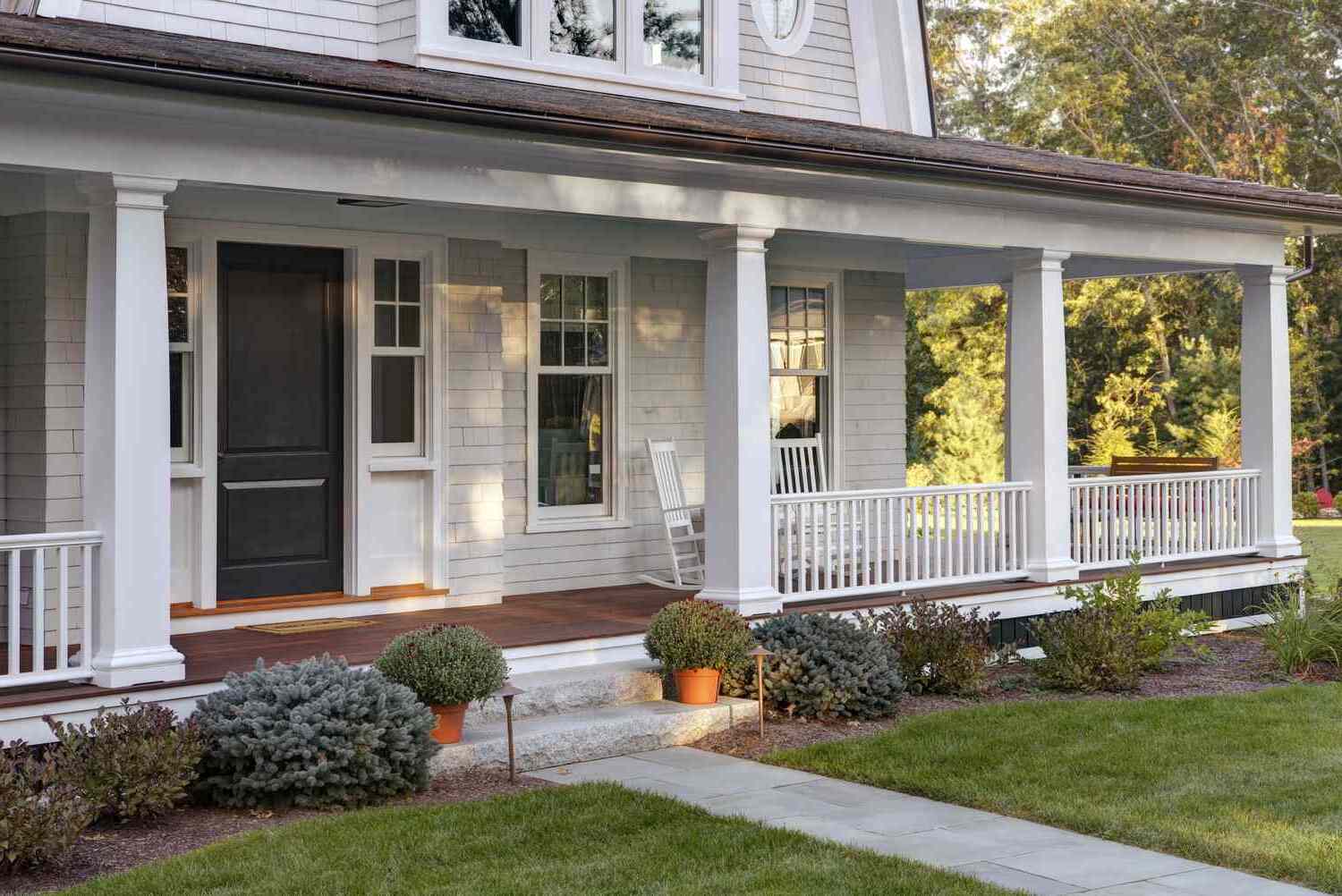Home>Create & Decorate>DIY & Crafts>How To Build A Porch


DIY & Crafts
How To Build A Porch
Published: February 27, 2024

Content Creator specializing in woodworking and interior transformations. Caegan's guides motivate readers to undertake their own projects, while his custom furniture adds a personal touch.
Learn how to build a beautiful porch with our DIY & Crafts guide. Get step-by-step instructions and expert tips for a stunning porch makeover. Start your project today!
(Many of the links in this article redirect to a specific reviewed product. Your purchase of these products through affiliate links helps to generate commission for Twigandthistle.com, at no extra cost. Learn more)
Introduction
Building a porch is an exciting and rewarding project that can enhance the beauty, functionality, and value of your home. Whether you envision a cozy space for sipping morning coffee or a welcoming area for entertaining guests, a well-designed porch can transform the exterior of your home and provide a charming extension of your living space.
When embarking on the journey of building a porch, it's essential to approach the project with careful planning, attention to detail, and a clear vision of your desired outcome. From the initial concept to the final finishing touches, each step of the process contributes to the creation of a space that reflects your personal style and meets your practical needs.
As you delve into the world of porch construction, you'll discover a wealth of design options, materials, and building techniques that can be tailored to suit your preferences and budget. Whether you opt for a traditional front porch with classic columns and railings or a modern, minimalist structure that seamlessly integrates with your home's architecture, the possibilities are as diverse as your imagination.
Before diving into the physical aspects of construction, it's important to consider the functional aspects of your porch. Will it serve as a peaceful retreat for relaxation, a gathering place for socializing, or a versatile area for multiple uses? Understanding the primary purpose of your porch will guide your decisions throughout the building process, from selecting the appropriate size and layout to choosing the right materials and amenities.
Additionally, building a porch involves adhering to local building codes and regulations, obtaining necessary permits, and ensuring compliance with zoning restrictions. By familiarizing yourself with these requirements early in the planning stage, you can avoid potential setbacks and ensure a smooth progression from concept to completion.
As you embark on this journey, keep in mind that building a porch is not just a construction project; it's an opportunity to create a space that reflects your personality, enriches your lifestyle, and adds character to your home. With careful planning, creativity, and a willingness to embrace the process, you can embark on this endeavor with confidence and excitement, knowing that the end result will be a cherished addition to your home.
Read more: How To Build A Front Porch With Roof
Step 1: Planning and Designing Your Porch
Before picking up any tools or materials, the first crucial step in building a porch is meticulous planning and thoughtful design. This phase sets the foundation for the entire project and greatly influences the functionality, aesthetics, and overall success of the finished porch.
Assess Your Needs and Preferences
Begin by envisioning how you intend to use the porch. Will it be a cozy spot for enjoying your morning coffee, a space for entertaining guests, or a multifunctional area for various activities? Understanding your specific needs and preferences will guide the design process and help determine the size, layout, and features of the porch.
Consider Architectural Harmony
Take into account the architectural style of your home when designing the porch. Whether your home boasts a traditional, contemporary, or rustic aesthetic, the porch should seamlessly complement the existing structure. Pay attention to details such as roof pitch, column styles, and railing designs to ensure a harmonious integration with the overall architecture.
Determine the Location
Carefully select the location of the porch, considering factors such as sunlight exposure, privacy, and accessibility from the interior of the house. Assessing these elements will help determine the most suitable placement for the porch, ensuring that it maximizes comfort and convenience.
Read more: How To Build A Porch Swing
Sketch the Layout
Create a rough sketch or use design software to visualize the layout of the porch. Consider the arrangement of furniture, traffic flow, and any additional features such as built-in planters or storage. This step allows you to experiment with different configurations and make informed decisions about the optimal layout for your specific needs.
Set a Realistic Budget
Establish a realistic budget for the project, factoring in materials, labor, and any additional amenities or decorative elements. Having a clear budget in mind from the outset will guide your material and design choices, ensuring that the project remains financially feasible.
Seek Inspiration
Gather inspiration from various sources such as home improvement magazines, online platforms, and architectural websites. Explore different porch designs, materials, and color schemes to spark creativity and refine your vision for the project.
Consult with Professionals
If you're uncertain about certain design aspects or technical considerations, consider consulting with an architect, designer, or experienced contractor. Their expertise can provide valuable insights and ensure that your design aligns with structural and aesthetic best practices.
By dedicating ample time to the planning and design phase, you lay a solid groundwork for a successful porch construction project. This thoughtful approach sets the stage for a well-executed design that harmonizes with your home, fulfills your lifestyle needs, and becomes a cherished extension of your living space.
Read more: How To Build Porch Steps
Step 2: Obtaining Necessary Permits and Permissions
Before commencing any construction work on your porch, it is imperative to obtain the required permits and permissions from the local authorities. Building codes and regulations vary by location, and adherence to these guidelines is essential to ensure the safety, structural integrity, and legal compliance of your porch.
Initiate the process by contacting your local building department or municipal office to inquire about the specific permits and permissions necessary for constructing a porch. Depending on the scope of your project and local regulations, you may need permits for activities such as excavation, foundation pouring, framing, electrical work, and plumbing.
Engage in open communication with the authorities to gain a comprehensive understanding of the permit application process, required documentation, associated fees, and inspection procedures. It is crucial to be well-informed about the timeline and requirements for obtaining permits, as this will impact the overall project schedule.
In some cases, your porch construction plans may need to undergo review by zoning boards or architectural review committees to ensure compliance with neighborhood covenants, historic district guidelines, or aesthetic standards. Understanding these additional layers of approval is essential for a smooth and legally sound construction process.
Once you have a clear understanding of the permit requirements, prepare and submit the necessary documentation, which may include detailed construction plans, property surveys, engineering reports, and proof of insurance. Be diligent in providing accurate and comprehensive information to expedite the permit approval process.
Upon receiving the permits, ensure that they are prominently displayed at the construction site as required by local regulations. Adhering to this practice not only demonstrates compliance but also facilitates inspections by building officials, who will verify that the construction aligns with approved plans and meets safety standards.
Failing to obtain the requisite permits and permissions can result in costly consequences, including fines, delays, and potential legal liabilities. By proactively addressing this crucial step, you demonstrate a commitment to responsible and lawful construction practices, setting the stage for a successful and stress-free porch building experience.
Remember, the process of obtaining permits and permissions is not just a legal formality; it is a vital component of ensuring that your porch construction adheres to industry standards, local regulations, and safety protocols. Embrace this step as an essential safeguard that contributes to the long-term integrity and value of your porch.
Step 3: Gathering Materials and Tools
Gathering the necessary materials and tools is a pivotal step in the porch construction process. The quality, suitability, and availability of these resources significantly impact the efficiency and outcome of the project. Before embarking on the procurement phase, it is essential to compile a comprehensive list of materials and tools based on the design and structural requirements of your porch.
Materials
The selection of materials for your porch should align with your design vision, budget, and environmental considerations. Common materials for porch construction include:
-
Lumber: Choose high-quality pressure-treated lumber for structural components such as posts, beams, and joists. Consider the aesthetic appeal and durability of the wood species for decking and trim elements.
-
Fasteners: Select corrosion-resistant screws, nails, and connectors suitable for outdoor applications. Stainless steel or galvanized fasteners are recommended to withstand exposure to the elements.
-
Foundation Materials: Depending on the chosen foundation type, gather concrete, gravel, and formwork materials for footings or piers. Ensure compliance with local building codes and soil conditions.
-
Roofing Materials: If your porch design includes a roof, acquire roofing shingles, underlayment, flashing, and related accessories. Opt for materials that complement the existing roof of your home.
-
Railing and Balustrade Components: Choose railing systems, balusters, and newel posts that enhance safety and aesthetics. Materials such as wood, metal, or composite offer diverse design options.
-
Flooring Options: Explore various flooring materials such as wood, composite decking, or stone tiles. Consider factors such as durability, maintenance requirements, and visual appeal.
-
Finishing Touches: Plan for exterior-grade paint, stain, sealant, and decorative elements to add character and protection to the porch.
Tools
Equipping yourself with the right tools ensures smooth progress and precision during construction. Essential tools for building a porch may include:
-
Power Tools: Circular saw, drill/driver, jigsaw, and miter saw for cutting, drilling, and shaping materials.
-
Hand Tools: Hammer, tape measure, level, chisels, and hand saws for precise assembly and adjustments.
-
Digging and Excavation Tools: Shovel, post hole digger, and wheelbarrow for preparing the foundation and site.
-
Safety Gear: Personal protective equipment such as gloves, safety glasses, and dust masks to prioritize safety during construction.
-
Lifting and Positioning Equipment: Depending on the scale of the project, consider renting or purchasing equipment for lifting heavy materials and positioning structural components.
By diligently sourcing the required materials and ensuring access to the appropriate tools, you set the stage for a well-equipped and efficient porch construction process. This proactive approach minimizes delays, facilitates smooth execution, and contributes to the overall success of your project.
Read more: How To Build A Screened In Porch On Concrete
Step 4: Building the Foundation
The foundation serves as the anchor of your porch, providing stability, load-bearing support, and protection against ground moisture. The construction of a solid and durable foundation is critical to the long-term structural integrity of the porch. The specific type of foundation chosen for your porch will depend on factors such as soil conditions, local building codes, and the design of the porch.
Assess Soil Conditions
Before commencing foundation construction, it is essential to assess the soil conditions at the site. Soil composition, drainage patterns, and load-bearing capacity play a significant role in determining the appropriate foundation type. Conduct soil tests or consult with a geotechnical engineer to gain insights into the soil's characteristics and make informed decisions regarding the foundation design.
Choose the Foundation Type
Common foundation types for porches include concrete piers, concrete slab-on-grade, and concrete footings. The selection of the foundation type depends on the porch design, local building codes, and soil conditions. Concrete piers are suitable for elevated porches, while slab-on-grade foundations are ideal for ground-level porches. Footings provide support for posts and beams, distributing the porch's weight evenly to the soil.
Excavation and Formwork
Once the foundation type is determined, proceed with excavation and formwork preparation. Excavate the designated areas to the required depth, ensuring uniformity and proper alignment. Construct formwork using lumber and stakes to contain the concrete and shape the foundation elements. Pay meticulous attention to the dimensions and alignment of the formwork to achieve precise foundation dimensions.
Read more: How To Build A Porch Roof
Pouring and Curing Concrete
With the formwork in place, it's time to pour the concrete for the foundation. Adhere to the recommended concrete mix design and pouring techniques to achieve the desired strength and durability. Ensure that the concrete is thoroughly compacted and free of air pockets. Following the pouring process, allow the concrete to cure according to the specified timeline, providing optimal conditions for hydration and strength development.
Inspections and Compliance
After the concrete has cured, schedule inspections by local building officials to verify the foundation's compliance with structural and safety standards. Inspections typically involve assessments of foundation dimensions, reinforcement, and concrete quality. Adhering to inspection requirements ensures that the foundation meets regulatory standards and sets the stage for the subsequent phases of porch construction.
By meticulously executing the foundation construction process, you establish a solid groundwork for the rest of the porch project. A well-built foundation provides the necessary support for the superstructure, ensuring stability, longevity, and safety for your porch. With the foundation in place, you are poised to progress to the next stages of constructing a functional and inviting outdoor space.
Step 5: Constructing the Frame and Roof
The construction of the frame and roof marks a significant phase in the porch building process, shaping the structural integrity and architectural character of the outdoor space. This step involves precise assembly, installation of load-bearing elements, and the creation of a weather-resistant covering to shield the porch from the elements.
Frame Construction
Commence the process by assembling the frame, which forms the skeleton of the porch structure. Utilize pressure-treated lumber for the frame components, ensuring durability and resistance to decay. Accurate measurements, level adjustments, and secure fastening are essential to achieve a stable and well-aligned frame. Depending on the design, the frame may include posts, beams, joists, and headers, each serving a specific function in supporting the porch's weight and accommodating the roof structure.
Read more: How To Make A Concrete Porch
Roof Installation
Following the frame construction, shift the focus to installing the roof, which provides shelter and visual cohesion to the porch. The choice of roofing materials, such as asphalt shingles, metal panels, or polycarbonate sheets, influences the porch's aesthetic appeal and weatherproofing capabilities. Carefully follow manufacturer guidelines and best practices for roof installation, ensuring proper flashing, underlayment, and ventilation to safeguard against water infiltration and moisture-related issues.
Roof Pitch and Drainage
Consider the roof pitch and drainage system to effectively manage rainwater and prevent pooling or leakage. The roof pitch, determined by the angle of the roof surface, influences water runoff and contributes to the porch's overall aesthetics. Incorporate gutters, downspouts, and proper flashing details to direct water away from the porch and protect the underlying structure from water damage.
Structural Integrity and Safety
Throughout the frame and roof construction, prioritize structural integrity and safety measures. Adequately secure the frame components with appropriate fasteners, ensuring robust connections and resistance to wind loads. Verify that the roof structure complies with local building codes and wind uplift requirements, reinforcing critical areas to withstand inclement weather and environmental stressors.
Aesthetic Considerations
Incorporate aesthetic details such as decorative trims, gable accents, or architectural embellishments to enhance the visual appeal of the porch. These finishing touches contribute to the porch's character and create a cohesive connection with the existing architectural style of the home.
By meticulously executing the frame and roof construction, you lay the groundwork for a resilient, visually appealing, and functional porch. This phase sets the stage for subsequent tasks such as flooring installation, railing assembly, and the addition of personalized touches that transform the porch into a welcoming and versatile outdoor retreat.
Step 6: Installing Flooring and Railing
With the frame and roof in place, the focus now shifts to the installation of flooring and railing, pivotal elements that contribute to the functionality, safety, and aesthetic appeal of the porch.
Flooring Installation
Selecting the right flooring material is crucial, considering factors such as durability, maintenance requirements, and visual appeal. Common options include wood decking, composite materials, and stone tiles, each offering distinct advantages in terms of longevity and aesthetics. Prior to installation, ensure that the substructure and frame are structurally sound and properly prepared to support the chosen flooring material.
Carefully lay the flooring material, adhering to manufacturer guidelines and best practices for fastening, spacing, and expansion joints. Attention to detail during installation is essential to achieve a level, secure, and visually pleasing surface that withstands foot traffic and outdoor exposure. Properly treated and sealed wood decking enhances resistance to moisture and UV damage, prolonging its lifespan and maintaining its natural beauty.
Railing Assembly
Railing systems play a critical role in enhancing safety and defining the visual character of the porch. When selecting railing components, consider the design cohesiveness with the overall architecture of the home, as well as compliance with local building codes and safety standards. Common railing materials include wood, metal, and composite options, each offering a range of styles and customization possibilities.
Install the railing system securely, ensuring that it provides adequate support and meets height requirements to prevent falls and ensure a secure perimeter. Pay attention to details such as baluster spacing, handrail ergonomics, and post anchoring to create a visually appealing and code-compliant railing system. Additionally, consider integrating lighting elements or decorative accents to further enhance the aesthetic and functional aspects of the railing.
By meticulously executing the installation of flooring and railing, you bring the porch one step closer to completion, transforming it into a safe, inviting, and visually captivating outdoor space. These elements not only contribute to the practical functionality of the porch but also serve as key design features that reflect your personal style and enhance the overall appeal of your home's exterior.
Step 7: Adding Finishing Touches
As the porch construction nears completion, the addition of finishing touches elevates the space from a functional structure to a welcoming and visually captivating outdoor retreat. This phase encompasses a range of details and embellishments that enhance the aesthetics, comfort, and personalization of the porch, creating a seamless integration with the existing architecture of the home.
Read more: DIY Porch Bed Swing Plans
Lighting and Ambiance
Strategically incorporating lighting elements contributes to the porch's ambiance and usability during evening hours. Consider options such as overhead fixtures, wall sconces, or integrated LED strips to provide illumination for relaxation, social gatherings, and enhanced safety. Lighting not only extends the porch's usability into the evening but also adds a warm and inviting atmosphere to the outdoor space.
Decorative Accents
Personalize the porch with decorative accents that reflect your style and create a cohesive connection with the surrounding environment. Consider elements such as potted plants, outdoor artwork, decorative screens, or seasonal decor to infuse character and charm into the space. These accents serve as focal points, adding personality and visual interest to the porch while harmonizing with the natural surroundings.
Furniture and Furnishings
Selecting appropriate furniture and furnishings transforms the porch into a functional and comfortable living area. Choose weather-resistant seating, tables, and accessories that align with your intended use of the space. Whether creating a cozy seating area, a dining nook, or a versatile entertainment zone, the right furniture selection enhances the porch's functionality and encourages relaxation and social interaction.
Protective Finishes
Applying protective finishes to the porch components ensures longevity and resistance to environmental elements. Consider staining or painting wood surfaces, applying sealants to stone or concrete elements, and treating metal components to withstand corrosion. These finishes not only preserve the aesthetic appeal of the porch but also contribute to the long-term durability and maintenance of the outdoor space.
Personal Touches
Incorporate personal touches that reflect your lifestyle and preferences, such as outdoor rugs, throw pillows, and decorative accents that resonate with your individual taste. These elements infuse the porch with a sense of warmth and personal connection, creating a space that feels like a natural extension of your indoor living environment.
By attending to these finishing touches, you bring the porch construction project to its culmination, creating a space that embodies your vision, enhances your home's exterior, and provides a versatile and inviting outdoor haven for relaxation and enjoyment.
Conclusion
In conclusion, the process of building a porch is a multifaceted journey that encompasses careful planning, meticulous execution, and a creative vision for transforming the exterior of your home. From the initial stages of conceptualizing the design to the final embellishments that infuse the porch with character and functionality, each step contributes to the creation of a space that reflects your lifestyle, enhances your home's curb appeal, and provides a welcoming outdoor retreat.
Throughout the construction process, the emphasis on thoughtful planning and attention to detail ensures that the porch aligns with your practical needs, architectural style, and local building regulations. By assessing your specific requirements, considering architectural harmony, and seeking inspiration from various sources, you lay the groundwork for a porch that seamlessly integrates with your home and enriches your outdoor living experience.
Obtaining the necessary permits and permissions, while often viewed as a regulatory formality, is a crucial step that underscores your commitment to responsible construction practices. Adhering to building codes, obtaining approvals, and engaging in open communication with local authorities set the stage for a smooth and legally compliant construction process, safeguarding the long-term integrity and value of your porch.
The careful selection and procurement of materials and tools, coupled with a focus on structural integrity and safety, ensure that the porch construction progresses efficiently and with precision. From building a solid foundation to framing the structure and installing the roof, each phase contributes to the creation of a durable, weather-resistant, and visually appealing outdoor space.
As the porch nears completion, the addition of flooring, railing, lighting, and personalized touches elevates the space from a construction project to a personalized sanctuary that reflects your style and enhances your outdoor lifestyle. The integration of finishing touches, such as decorative accents, furniture, and protective finishes, infuses the porch with warmth, character, and functionality, creating a space that invites relaxation, socialization, and personal enjoyment.
In essence, the process of building a porch is not merely a construction endeavor; it is an opportunity to craft a space that enriches your daily life, extends the warmth of your home into the outdoors, and provides a canvas for creating cherished memories with family and friends. By embracing the journey of porch construction with creativity, attention to detail, and a clear vision, you have the potential to transform your home's exterior into a captivating and inviting oasis that reflects your unique personality and enhances your overall living experience.








